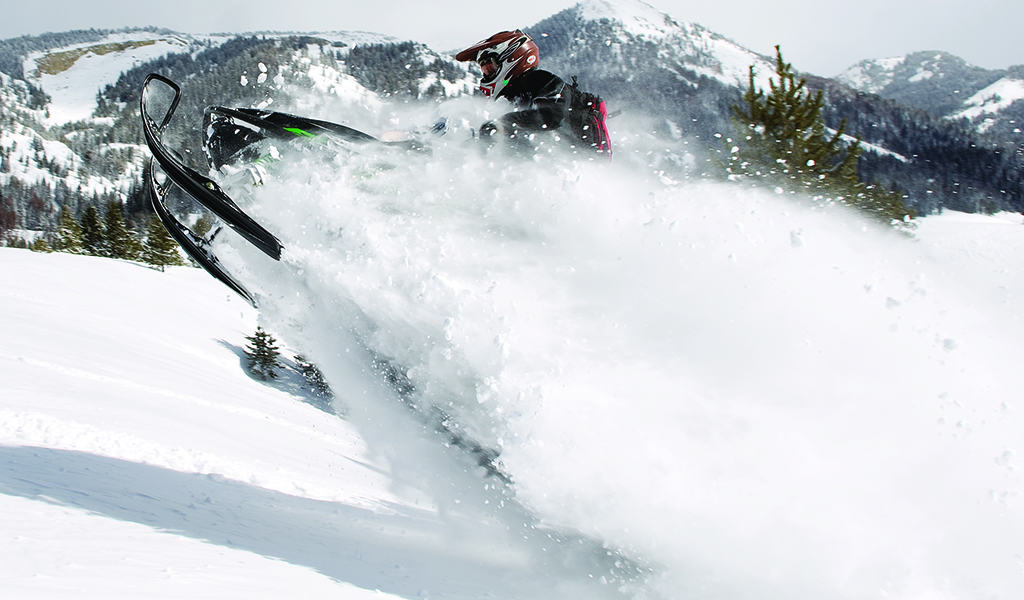Read The
Current Issue
RIDING HIGH
In Jackson Hole, snowmobiling isn’t just a sport, but a culture.
By johanna love
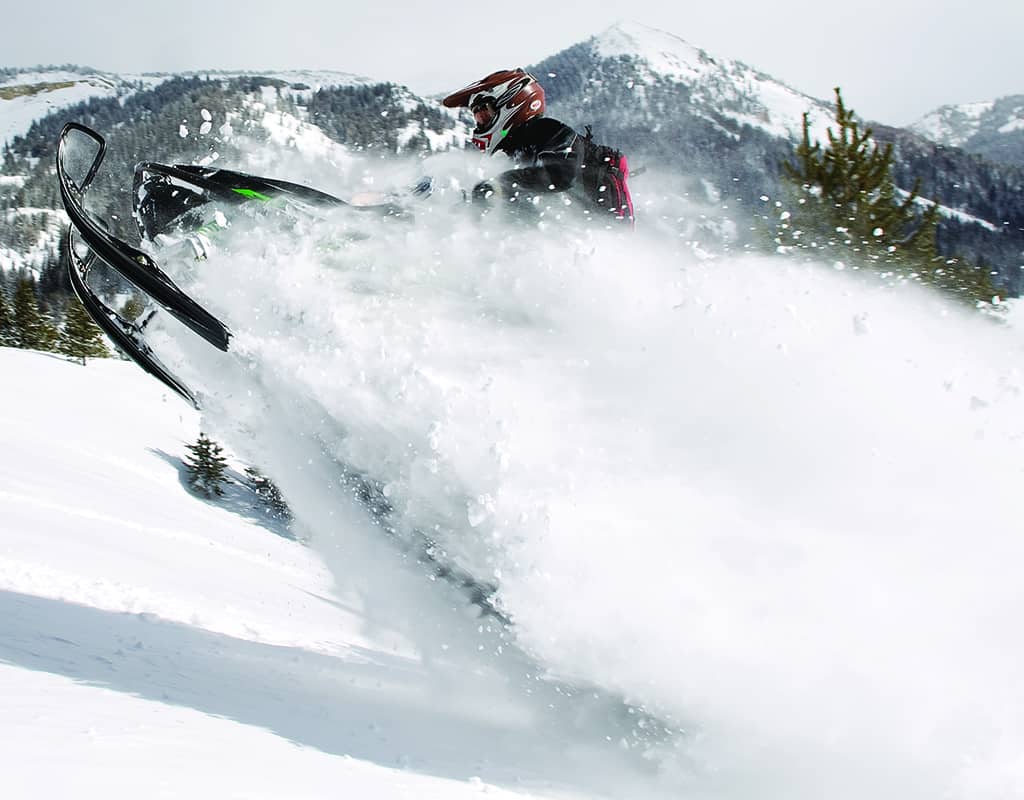
IT’S RACE DAY for Ryley Hasenack, and her stomach is turning backflips. The thirteen-year-old is lined up on her six-hundred-cubic-centimeter snowmobile, and almost all the other kids around her are boys. The machines emit a low rumble, and when the light turns green she releases the brake lever and hits the throttle hard, spraying snow all over the other snocross racers. She gets the hole shot—first sled into the turn—and that puts her out in front as the one to beat.
The slender blonde flies around the track, whipping through tight turns, flying over jumps, and not missing a beat in rhythm sections. Sometimes she bumps up against other machines. A few years ago, Hasenack was shier and reluctant to be aggressive. “I had to learn to hold my ground, to start learning how to push back,” she says. “Now I’m not afraid to do that. If you’re nice, you’re not going to do well.”
When she hits a jump, she must have enough speed and the right body position to land it “smooth as butter.” If she loses confidence, it could cost her not only the podium, but also a broken sled or broken bone. “If you go into it half-committed, you won’t come out of it well,” says Hasenack, who started racing at age seven. “You’re gonna have to hit it hard.” Hasenack goes all out for her entire race, eight laps of the three-quarter-mile track.
For this race, the national finals on the International Series of Champions (ISOC) circuit, her whole family—mom Shannon, dad Brian, and brother Brody—has driven 1,400 miles to Lake Geneva, Wisconsin, in a one-ton truck towing an enclosed trailer loaded with five sleds. About six weekends each winter they leave the family’s Jackson roofing business so Ryley can “put the whoopins on the boys,” as Brody says, in races on the national snocross circuit. Brody’s on the circuit, too, but at age eleven he doesn’t beat Ryley much yet. She’s calculated and skilled and pushes the envelope just enough. He’s focused and fearless, “a crash test dummy,” he says.

Most winter evenings they’re practicing, running laps on the snocross track their father built on their property near Hoback Junction. He collects snow from across the neighborhood and molds it into a racetrack. Snowmobiling is a way of life for the Hasenacks, who call themselves “motorheads” and ride under their brand, Hold Fast Racing. “We’re on snowmobiles as much as possible,” Brian says.
Growing up in southern Colorado, Brian began riding snowmobiles at age five and introduced his wife to the sport soon after they met in the early 1990s. Their children have known the throbbing of an engine since they were in the womb and were riding their own miniature 120cc sleds before they started kindergarten. Most of the kids’ Jackson Hole friends ski each weekend, but they’ve made snowmobile-racing friends who are scattered around the West.
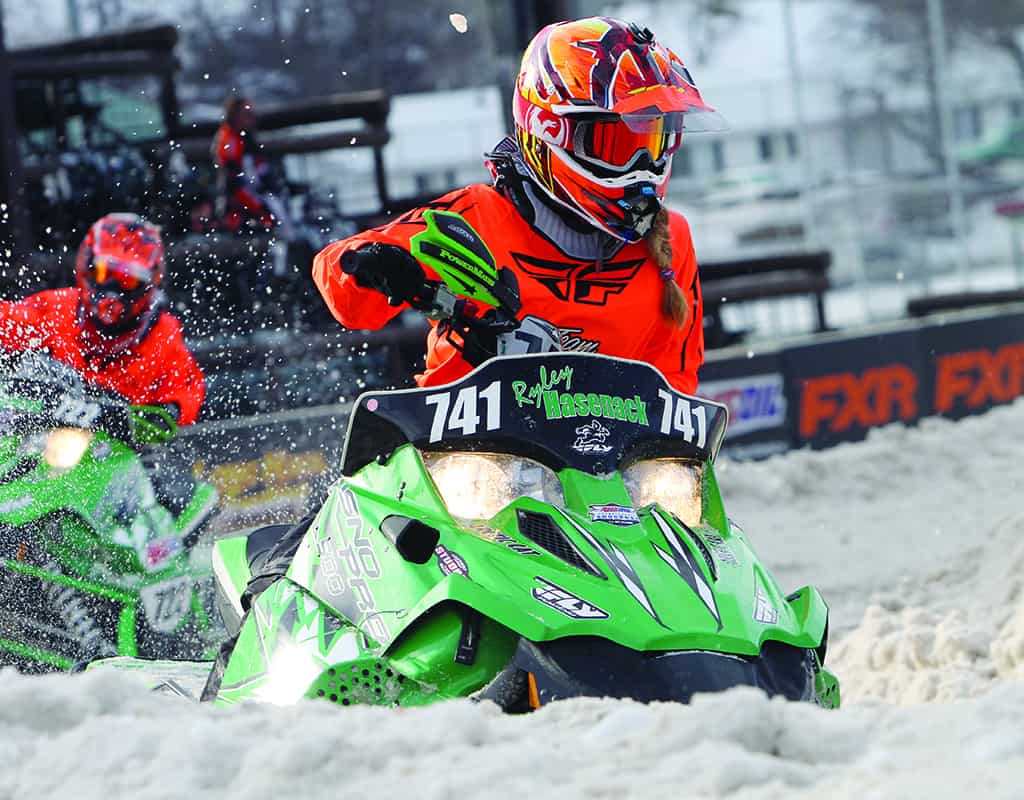
IT WAS MORE than half a century ago that snowmobiles were introduced in Jackson Hole. At first it wasn’t for sport. Ranchers used them to access herds of cattle or travel to town on unplowed roads. It didn’t take long for others to see that riding a motorized sled across snow was fun. The Jackson Hole Snow Devils, a snowmobiling club, formed in 1964, hosting social rides, oval races at the Teton County Fairgrounds, and cross-country races up Mosquito Creek near Wilson.
It was 1968 when valley mechanic Ted George bought his first snowmobile, an Arctic Cat. With friends, he took off each weekend on epic overnight trips through Yellowstone National Park to West Yellowstone, Montana, or along Grassy Lake Road to Ashton, Idaho. The machines only held 3.5 gallons of fuel, so they packed along several gas cans. “There was virtually no rules and no rangers,” George says. “You had to break your own trail.” George, now seventy-two, has ridden snowmobiles every winter since then. “I just fell in love with them and been on them ever since,” he says.
Getting deep into the backcountry is his primary motivation these days.
“You can go in half an hour on a snowmobile where it would take you all day to walk back,” George says. “You leave tracks but they melt off, and it doesn’t look like anybody’s ever been there. It’s just fabulous.”
Even though the Hasenacks are busy racing, they do get out and play like George. When there’s no race or training on the schedule, the family spends weekends on Togwotee Pass, where there are 829 miles of marked and groomed trails along the Continental Divide and tens of thousands of acres for freeriding high in the Bridger-Teton National Forest. “Going to Togwotee is like going to Mecca,” says Jeff Golightly, CEO of the Jackson Hole Chamber of Commerce and the former general manager (for twelve years) of Togwotee Mountain Lodge, which offers overnight accommodations, snowmobile rentals, and guided trips, and is completely booked almost all winter long. “Lots of publications do rankings on the best places to ride in the country, and Togwotee is always [in the] top three, usually number one. Togwotee is to snowmobilers what Jackson Hole Mountain Resort is to skiers.”
Togwotee is the preferred destination for locals, too. “Up there,” Brody says, “you can carve, and you feel like nothing can stop you at that moment.” Ryley adds, “except ditches and holes and rocks and that stuff.”
The young snowmobilers like to freeride with their parents, mostly technical lines through the trees. “Technical riding makes the kids better riders,” says Brian, who keeps extra sleds in his fleet to introduce friends to his favorite sport. “They have to think, pick and pull their lines or you get stuck.”
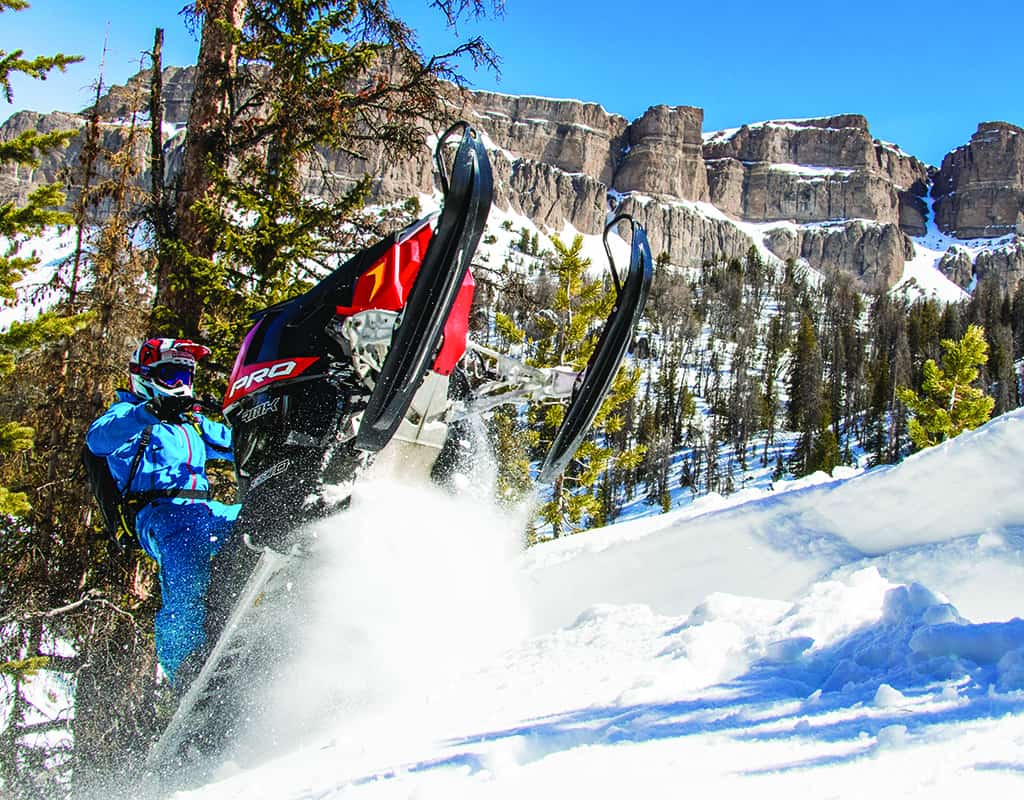
THERE ARE MORE than 33,000 snowmobiles registered in Wyoming, and seventeen snowmobiling clubs around the state, including the Snow Devils. Nationally, snowmobile sales increased 8 percent in 2015, according to the International Snowmobile Manufacturers Association. Most Wanted Performance in Jackson is seeing 15 to 25 percent sales growth each year, says part-owner Tyler Doucette. For five years, the crew at the shop has been aiding snowmobilers of all stripes, “from full-blown motorheads to people who use them to get into the backcountry for skiing.”
Real motorheads, Doucette says, get a new machine every two to three years. They enjoy it for a few years and then sell it while they can still get good money for it before investing in the newest technology, which is always improving. Today’s mountain sleds have more horsepower, are thinner and lighter, and have longer tracks to push more snow. “It’s unreal,” Doucette says. “About every four years a new chassis and new motor and a new something else comes out.”
Snowmobiling is not cheap. New models cost an average of $13,000. On top of that, riders need a helmet, goggles, boots, pants, jacket, and avalanche gear, including a shovel, beacon, probe, and, ideally, an airbag backpack that could keep you on top of a snow slide. This is easily another $1,500.
Snowmobiles are used for many purposes and are becoming increasingly specialized. There are sleds for snow-covered roads and groomed trails, off-trail backcountry riding, snocross racing, track racing, and hill climbing. The most popular snowmobiles in town are specialized for mountain riding. Polaris’ model is the RMK, which stands for Rocky Mountain King. It’s what you see most often around Jackson Hole, whether it’s being used for high-marking, playing in open meadows, or hauling skiers or snowboarders uphill.
While skiing gets more attention, snowmobiling is an integral part of the winter fabric of the valley and draws visitors as well, Doucette says. “We live in the most pristine country in the world to do these winter sports,” he says. “It’s always been a ski town. But as a snowmobile town, we get people from all over the world because it’s so world-renowned.”
The main difference between skiing in Jackson Hole and snowmobiling? One of them is crowded, says Jacob Stark, who purchased his season pass at Jackson Hole Mountain Resort for nine years before putting that money toward a snowmobile two years ago. “It’s been so advertised,” Stark says.
“When I take a day off of work to go play and sit in the tram line till 11:30 for a decent run, it’s not worth it. I can take my snowmobile, go to the backcountry, take my snowboard, and have a better experience in many ways. I’m out there by myself with my friends.”
According to Doucette, more and more skiers and snowboarders are walking into Most Wanted Performance to buy a snowmobile to access the backcountry. “There are no lift lines with a snowmobile,” he says.
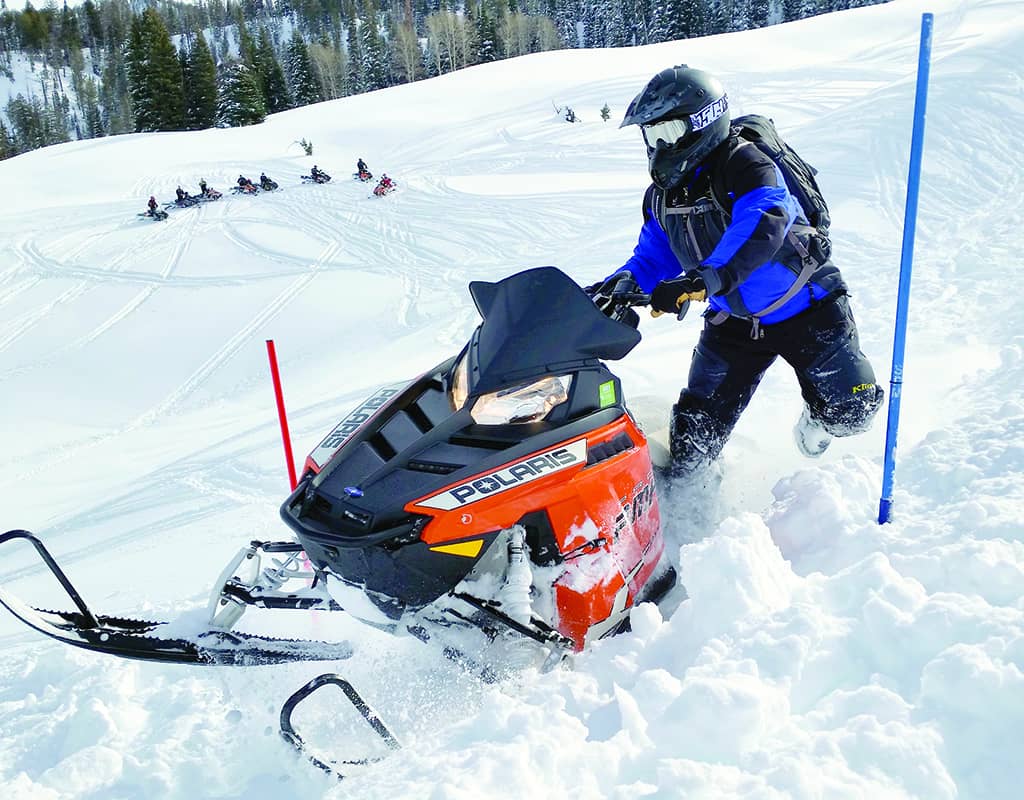
WHILE BACKCOUNTRY RIDING and skiing each have their own culture, they share the need to know about safely navigating avalanche terrain. (Since January 2010, twelve backcountry skiers have died in avalanches in the Jackson Hole area; avalanches have killed six snowmobilers in the same time frame.) Dan Adams started Next Level Riding Clinics in 2008 partially to educate snowmobilers about avalanches. From his base in Alpine, Adams leads small groups, a mix of visitors and locals, on two-day adventures into the Greys River drainage in the Bridger-Teton National Forest.
Courses include snowmobile maneuvering, footwork, body positioning, and avalanche awareness. During his two decades of backcountry riding, Adams has seen and been a part of many avalanches. “When you see that happening, it changes you,” he says. “You really get a grasp of the power of Mother Nature. Practice is never gonna make perfect, but practice is gonna make prepared. It’s not if it happens, but when it happens.”
Adams grew up south of Jackson, in an area where he and his siblings had to ride snowmobiles to the school bus stop. He began taking his sled off-trail first to access backcountry snowboarding lines, but soon the thrill of the machine won out. He was one of the riders in Slednecks’ 1998 self-titled movie, which is full of high-flying hijinks. Riders catch major air while lifting their bodies into Superman poses or doing heel clicks. By the eighth movie, Adams was featured doing a backflip. While Adams left the group a while ago, the Slednecks continue to put out DVDs and now design clothing.
Their eighteenth film was released in fall 2015.
About a decade ago Adams realized that when he offered friends just a few technique tips, their riding improved exponentially. Seeing a rider get to the next level is his favorite part of his clinics. “I get to unlock people’s hidden potential,” he says. “When they come here they don’t believe in themselves enough. When I make the impossible possible for them, that really helps charge me.”
Because Adams teaches people to ride in a mountain environment, summiting a peak like Elk Mountain is often part of the package. Snowmobiling to 10,000 feet, miles away from any road, is an exhilarating experience, the ultimate feeling of freedom, isolation, camaraderie, and spirituality all at once.
Doucette, who races up hills as part of the Rocky Mountain Snowmobile Hillclimb Association and enjoys mountain riding with his friends, says the different snowmobiler user groups share a common culture. “They’re level-headed, friendly, and no one really judges,” he says. “I love the friendships when out riding with buddies.”
George agrees. “The snowmobile group is a good bunch of people,” he says. “They all help you, help each other, help anybody that’s broke down.”
Carter Gerdes, Togwotee Mountain Lodge’s longest-serving guide (this will be his twentieth winter), challenges residents and visitors alike: “Go get on a sled just once this year. Go see how much fun it is.”
Ride Like a Local
You might not be doing heel clickers off a sick jump like Dan Adams of Next Level Riding Clinics, but trail etiquette, courtesy, and following the rules will keep you from looking like a newbie. “Everyone’s welcome as long as they’re respectful,” says Tyler Doucette, part-owner of Most Wanted Performance.
• Be courteous to other user groups like cross-country skiers. “Don’t haul ass past them,” Doucette says. “Don’t give us a bad name because you want to be a speed demon.”
• Don’t trespass on private lands.
• Don’t poach the wilderness, national parks, or forest lands that are closed to protect wintering wildlife.
• If you buy a snowmobile, register it each year with the state. The $35 fee goes to pay for trail grooming. Even if trail riding isn’t your objective, the trails are how you get to the backcountry powder. “Everybody likes to ride on nice, smooth trails,” says Ray Spencer, winter sports coordinator for the Bridger-Teton National Forest.
• When you get your sticker, donate at least the requested $2 extra to search and rescue. “Pay it,” Doucette says. “None of us ever wants to use it. But support them.”
• Bring avalanche rescue equipment—beacon, shovel, probe, airbag pack—and know how to use it. Check the Bridger-Teton’s Avalanche Center (jhavalanche.org) before every outing to assess conditions and report observations after your ride.
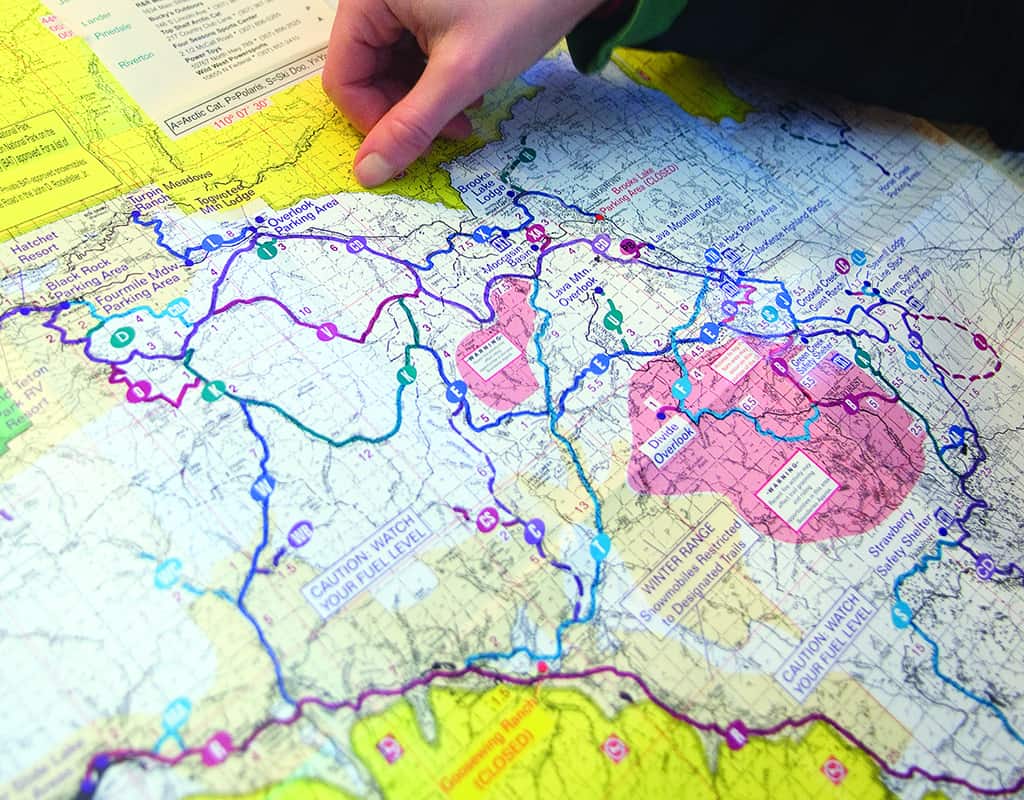
A Few Favorite Rides
Continental Divide trails to Brooks Lake Lodge
Built in 1922 to serve early Yellowstone National Park visitors, the luxe Brooks Lake Lodge sits more than five miles from any plowed road—so the only way to get there is via sled, snowshoes, or skis. If you can’t afford a room, the lodge is open to nonguests for lunch. Don’t miss the Mountain Man Nachos. brookslake.com
Greys River Road to Box Y Lodge
It takes a while to wend your way back 30 miles from Alpine to the Box Y, between the Wyoming and Salt River ranges, and many tempting meadows will try to lure you in. But once you’re there, warm hospitality makes up for the lack of cell service. boxylodge.com
Grassy Lake Road to Headwaters Lodge & Cabins
Start at Flagg Ranch for a scenic out-and-back journey along the road between the John D. Rockefeller Jr. Memorial Parkway and Ashton, Idaho. Turn around in time for elk and bison chili. gtlc.com/headwaters-lodge.aspx
Choose your own adventure to the Red Fox Saloon
Hundreds of miles of trails through millions of acres of forest mean any number of adventures will occupy you until hunger and thirst finally force you to pilot your sled back to Togwotee Mountain Lodge for hot wings, a chicken quesadilla, or a friendly game of billiards. togwoteelodge.com
Soak in Hot Springs
The only way to access Granite Hot Springs in the Bridger-Teton National Forest in winter is by snowmobile, cross-country skis, dog sled, or fat bike. It’s about 11 miles each way, and the historic hot springs pool is fed by a 112-degree natural spring. fs.usda.gov/recarea/btnf

